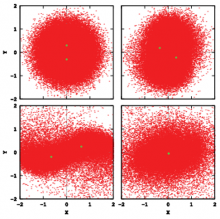
Abstract
Binary supermassive black holes (SBHs) form naturally in galaxy mergers, but their long-term evolution is uncertain. In spherical galaxies, N-body simulations show that binary evolution stalls at separations much too large for significant emission of gravitational waves (the ``final-parsec problem''). Here we follow the long-term evolution of a massive binary in more realistic, triaxial and rotating galaxy models with particle numbers as high as 106. We find that the binary does not stall. The binary hardening rates that we observe are sufficient to allow complete coalescence of binary SBHs in 10 Gyr or less, even in the absence of collisional loss-cone refilling or gasdynamical torques, thus providing a potential solution to the final-parsec problem.